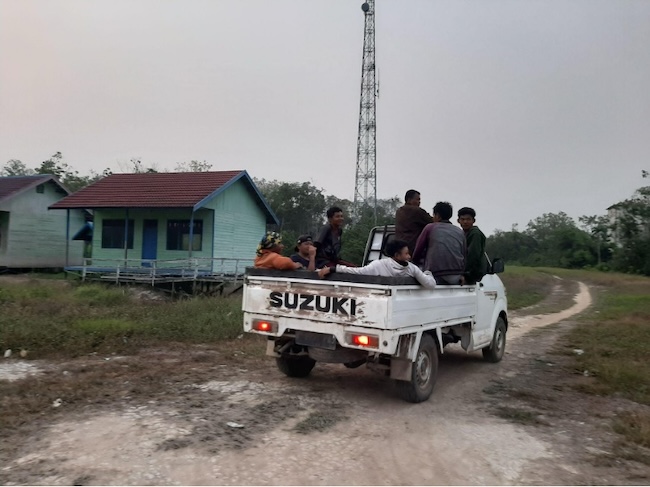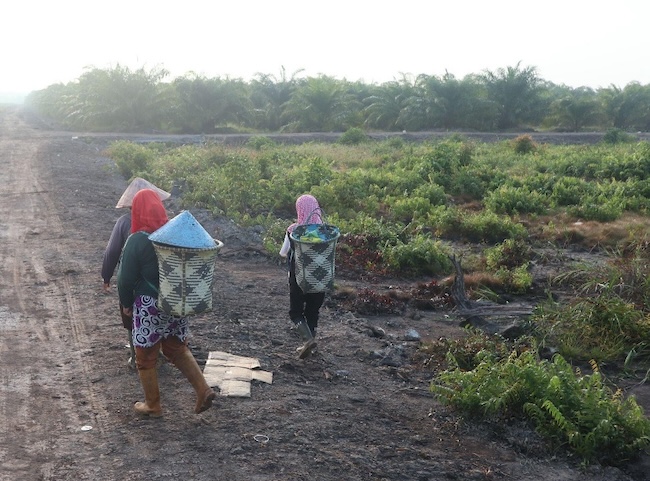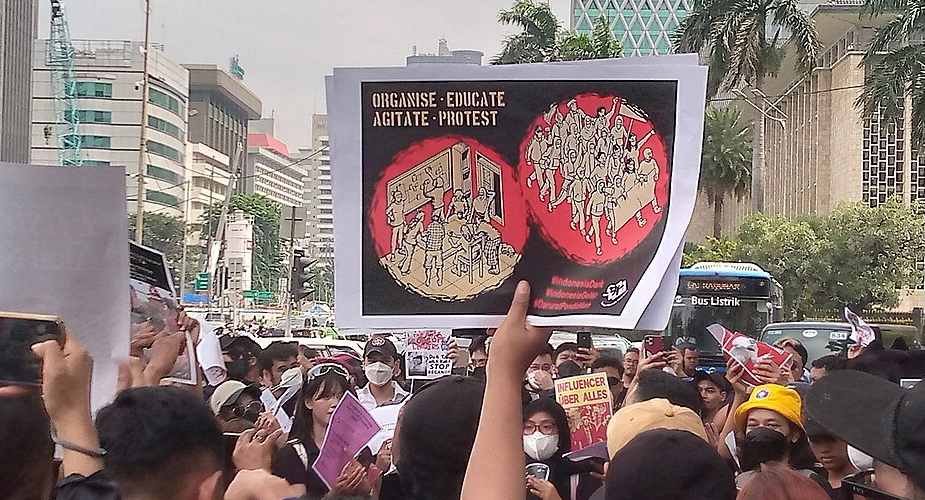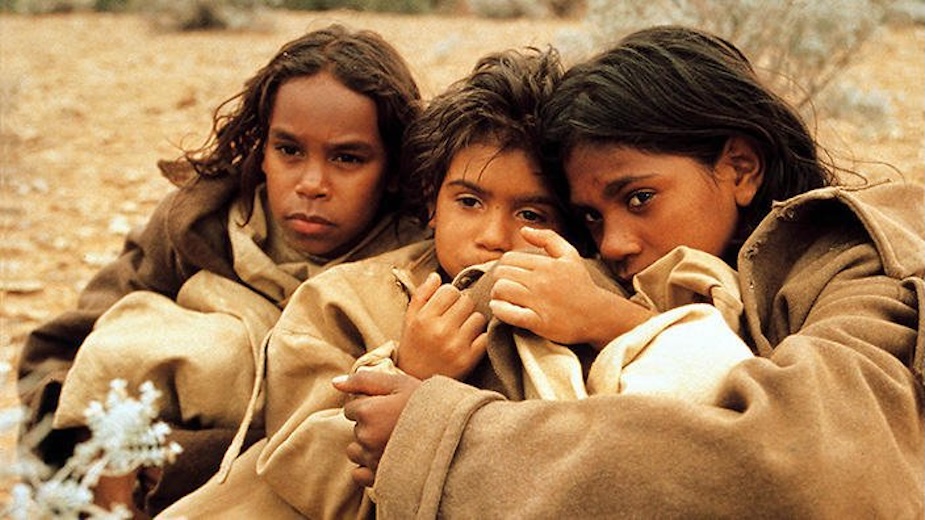There have been improvements in understandings about the importance of women’s roles in community-based environmental initiatives, but in the realm of fire governance there is still a long way to go
Hanina Naura Fadhila & Sofyan Ansori
‘Miss, it will be better if you find a shaded place to stand. Let your male colleague take the pictures if you need documentation.’ This is the instruction Pak Rahim, leader of the community fire brigade in Tumbang Bulan village, gave to researcher, Hanina. It was a scorching hot afternoon and Hanina and her colleague Hafiz had accompanied the team to this fire site in Mendawai sub-district, Central Kalimantan, to observe their operations.
The wildfire joint operation consists of village fire brigades, local police officers and local army officers. To maintain good relations with the Indigenous interlocutors in the village Hanina reluctantly obeyed, moving some distance away. From there she watched as Pak Rahim's group allowed Hafiz to enter the arena though, like her, he was not part of the operation. Hafiz was even asked to join in and assist the fire brigade to carry the water hose.
A few months earlier, members of the community fire brigade in a Dayak village in Cempaga sub-district explained to another research team member, Sofyan, that involving women in fire patrol would be awkward and risky. The reasoning given was not based solely on the need for a particular level of physical strength to carry out the tasks involved, but because the patrol units were organised in pairs or groups of three people. As such, the brigade members told Sofyan, having a female member would not be seen as ‘right’ by their family, as the activities often required camping overnight in the forest. ‘We would be the subject of people’s gossip here in the village,’ they explained.

These experiences illustrate the everyday challenges within fire mitigation efforts. For generations, Dayak women and men shared the peatlands and were collectively responsible for managing the forest and ladang (shifting cultivation), and spaces for fishing and deer-hunting. During three months of ethnographic fieldwork in Mendawai sub-district, Katingan regency, we observed a highly masculine discourse and practice in fire management. While there have been improvements in understanding about the importance of women’s roles in community-based environmental initiatives more broadly, in the realm of fire governance women appear to be excluded.
‘Community’ participation
The 2023 blazes were not the first such fires experienced by the people of Tumbang Bulan. The Dayak people of this region also experienced intense fires back in 2019, 2015 and 1997–1998. Fire hotspots around the village have an added risk as it is adjacent to Sebangau National Park conservation area and plantation concessions. As such, since 2019, villagers have taken on new roles and have become an inherent part of fire mitigation in the area. For some years now, the Indigenous people have been educated in fire mitigation by government bodies and private corporations. The Indonesian government has emphasised the important role of village-level community fire brigades as the spearheads of control mechanisms and operations in fire-prone areas. The aim is to foster community participation and prepare villagers to be self-sufficient first responders.
Our research focuses on Indigenous fire governance at the local level, so we are attuned to the complexities of such participation. Our observations so far suggest that participation on the ground often looks very different from how people might have initially imagined it, overlooking certain aspects including the gendered dimension of fires that hinder women's contributions. The evidence shows that women have been missing from the design and implementation of Masyarakat Peduli Api, (Fire Care Society), the fire patrol or the fire operation. Fire control activities in Central Kalimantan are male-dominated spaces where Dayak women's presence and participation were neither welcomed nor wanted.
Between auxiliary and outcast
At a preschool in Tumbang Bulan village, Hanina observed the children attentively following the teacher’s aerobic moves alongside Bu Eli, the preschool’s founder and principal. As they began to chat about Hanina’s reason for being in the village, it became clear that Bu Eli was not only essential to education provision in the community, but also performed a crucial role in fire prevention and mitigation. Bu Eli explained that she was also acting ‘unofficially’ as fire brigade treasurer for the village. She assisted her husband who worked for a conservation non-governmental organisation (NGO) and whose duty included facilitating village fire brigade operations (patrol and mitigation) as part of an engagement process between the NGO and the community. Hanina found that Bu Eli possessed a considerable knowledge of fire and peatland, certainly more than most villagers we spoke with in Tumbang Bulan. However, this work and expertise in fire management went unnoticed or unacknowledged, with locals referring to her as Ibu Ngaji (religious teacher) or merely Pak Ali’s wife.
We soon discovered that Bu Eli was one of a kind. Women’s participation in fire management is typically unwanted and this can significantly disadvantage women. Mama Rayhan, from Perigi village, works for a palm oil company as a casual laborer and her husband is a corporate truck driver. When fires were raging around the plantation, she was deeply anxious because it would mean no work for her for a while. This was not the case for her male colleagues. Mama Rayhan’s husband, for instance, was thriving during the fires because male workers can receive up to three times their daily wages for assisting the palm oil corporate firefighters to put out the fires. This opportunity is not afforded to female workers. The fires immediately turn this traditionally shared physical landscape into an exclusively male space.

Dayak women are not alone in experiencing this kind of exclusion. In late September 2023, Hanina was attempting to conduct a participant observation of a fire operation. The group of all male firefighter volunteers had gathered on the village field where a truck was parked ready to transport them to the fire sites. Hanina approached the crowd to investigate the possibility of joining them. Instead of welcoming her, the crowd launch into catcalling. For her own safety, Hanina decided to stay behind. She did not want to risk having to stay out overnight with the group. This feeling of insecurity and vulnerability was not a sudden response, but the accumulation of Hanina’s past experiences of opposite-gender interactions, including catcalling.
(Re)production of gender narratives
The attribution to women as either ‘the other’ or ‘second class’ in fire operations signals a broader problem in community participation. This process did not happen in a vacuum but is the consequence of long-term gender narratives perpetuated by environmental and development programs.
A gender-based labor division was implemented in the conservation program called Restorasi Sungai Bulan (Bulan River Restoration) led by a conservation NGO in collaboration with the Ministry of Forestry and Environment. The goal was to restore the forest ecosystem in the post-timber-industry era in tandem with fire prevention and mitigation in the conservation area. The program divided the roles of male and female villagers into two contrasting tasks. Females and elders were assigned to the nursery processes around residential areas, while males were tasked with cultivating the seed in the forest. The program expressed a subtle preference for which gender was more suitable for the different tasks, disregarding the long-time equal relationships between Indigenous Dayak men, women and their surrounding forests.
Another program we observed also maintains similar ideas about gendered division of labor within village–corporation engagement in fire prevention. The collaboration, which is backed by an ecosystem restoration company, includes funding operational costs, fire mitigation training and weekly fire patrols. While such collaborations speak of promoting gender inclusion, none of the proposed programs for the company’s fire management intervention has an unequivocal gender policy, particularly where women's participation is concerned.

Hanina once asked a male staff member of a corporation involved in such a program about female participation in a fire patrol he led. To Hanina's surprise, he responded frankly, telling her that women were a burden for the operation. A female worker from the same company later shared that women were not allowed to join in and were regarded as inappropriate to engage in this kind of work. She posited that fire prevention works better if it is carried out by men than women, as male workers were reckoned to be more ‘capable’ of navigating the vast peatland forests. The attitude was also apparent in the way the workplace was organised. At the company’s local headquarters, the door leading to the Protection Division room – the frontline in prevention and mitigation of fire in their concessions – carries a sign prohibiting women from entering. Such a sign says a great deal about the exclusionary and gendered logic of the fire initiatives. These cases depict how environmental and developmental programs might put women in unfavorable positions and are responsible for setting invisible barriers in fire governance and beyond.
Meaningful inclusion?
The barriers to female inclusion in fire governance work we witnessed in our research, reference the underlying and widespread problems with equity in conservation, ecosystem restoration and fire mitigation. As we have discussed, women are frequently sidelined, discouraged or assigned to domestic work, even in so-called participatory programs.
Nevertheless, there are some cases of women serving at the forefront of conservation efforts – the work of Acehnese women in Leuser National Park, Dayak women in West Kalimantan and Ranu Welum Foundation in Central Kalimantan. These examples have also shown that women's long-time engagements and connections with the environment, as well as cultural and bodily experiences, are pivotal in changing thinking and forming alternative models for the existing fire initiatives.
We have not yet witnessed such success stories in our own field sites. As the possibility of future fires lingers, we wonder whether Bu Eli, Mama Rayhan and other Dayak women will continue to face the same conditions and restrictions. A discussion of the gendered dimension of fire initiatives does not aim to diminish the domestic work performed by women, nor to endorse double burden narratives. It is our hope that it will reveal the day-to-day reality of women's participation in environmental works and, in doing so, encourage an alternative model to push for meaningful and equal participation.
Hanina Naura Fadhila (hanina.naura@alumni.ui.ac.id) graduated cum laude from the Department of Anthropology, Universitas Indonesia in 2023. Sofyan Ansori (sofyanansori2022@u.northwestern.edu) is a PhD Candidate in the Department of Anthropology at Northwestern University.












